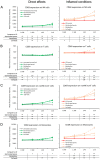Differential Immune-Modulating Activities of Cell Walls and Secreted Metabolites from Probiotic Bacillus coagulans JBI-YZ6.3 under Normal versus Inflamed Culture Conditions
- PMID: 37894222
- PMCID: PMC10609156
- DOI: 10.3390/microorganisms11102564
Differential Immune-Modulating Activities of Cell Walls and Secreted Metabolites from Probiotic Bacillus coagulans JBI-YZ6.3 under Normal versus Inflamed Culture Conditions
Abstract
Spore-forming probiotic bacteria, including Bacillus coagulans, are resilient and produce a variety of beneficial metabolites. We evaluated the immune-modulating effects of the novel probiotic strain Bacillus coagulans JBI-YZ6.3, where the germinated spores, metabolite fraction, and cell wall fraction were tested in parallel using human peripheral blood mononuclear cell cultures under both normal and lipopolysaccharide-induced inflamed culture conditions. The expression of CD25 and CD69 activation markers was evaluated via flow cytometry. Supernatants were tested for cytokines, interferons, chemokines, and growth factors using Luminex arrays. The germinated spores were highly immunogenic; both the cell wall and metabolite fractions contributed significantly. Under normal culture conditions, increased levels of immune activation were observed as increased expressions of CD25 and CD69 relative to natural killer cells, suggesting an increased ability to attack virus-infected target cells. On monocytes, a complex effect was observed, where the expression of CD25 increased under normal conditions but decreased under inflamed conditions. This, in combination with increased interleukin-10 (IL-10) and decreased monocyte chemoattractant protein-1 (MCP-1) production under inflamed conditions, points to anti-inflammatory effects. The production of the stem cell-related growth factor granulocyte colony-stimulating Factor (G-CSF) was enhanced. Further research is warranted to characterize the composition of the postbiotic metabolite fraction and document the characteristics of immunomodulating agents secreted by this probiotic strain.
Keywords: T cells; anti-inflammatory; chemokines; cytokines; granulocyte colony-stimulating factor (G-CSF); monocytes; natural killer (NK) cells.
Conflict of interest statement
The authors declare no conflict of interest. The funders had no role in the design of the study; in the collection, analyses, or interpretation of data; or in the writing of the manuscript. The funders supported the decision to publish the results.
Figures






References
Grants and funding
LinkOut - more resources
Full Text Sources
Molecular Biology Databases
Research Materials
Miscellaneous

